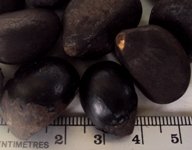For kaong seed propagation and nursery care, the following steps are outlined:
1. Harvest ripe fruits, indicated by the yellowing of the outermost part or skin.
Otherwise, collect seeds under the canopy of mature palms.
The seeds should have no holes which serve as entry of seed borers. Then put the seeds in a pan of water. Discard the seeds that float.
Use only the seeds which sink to the bottom because they have high probability of seed germination (but not certainty).
Kaong seeds are recalcitrant just like other palms, that is, they easily loss viability when dried to a critical level.

2. Extract the seeds by pressing on the fruits with the sole of the shoe.
Take care in handling the fruit.
As in many palms, the sap from the fruit can cause severe irritation. Use a stick or glove to collect the seeds;
3. Air-dry the kaong seeds;
4. Subject the seeds to pregermination treatment following the procedures for scarification, warm water treatment, or removal of hilum cover (read Sweet Palm or Kaong Propagation Methods ).
5. Sow or insert the seeds on a seedbed or in a pot of coarse (sandy) medium. The depth of sowing should be about the thickness of the seeds;
6. Prick the seedlings before the leaves open and transfer them into a potting container.
Plastic bags with sizes ranging from 6 in. x 8 in. to 8 in. x 11 in. can be used. Puncture the sides close to the bottom and insert the corners.
Use sandy loam soil as potting medium or mix clayey soil with river sand at a 2:1 ratio by volume.
Fill the pot up to about a half-inch below the rim. This unfilled portion will serve as a water trap.
Note: The germination of kaong seed starts with the emergence of the shoot from the seedbed.
It is then followed by the emergence of the seed with a peg attached to the base of the seedling.
In pricking and transplanting of the seedling to a suitable container, the seed should not be severed because it supplies nutrients to the seedling.
7. Pile the potting containers by block with a width of around 70 cm (27.5 in).
This will accommodate 5-7 pots, depending on size.
Provide vacant space between blocks to serve as the alley. Where a wheelbarrow is intended to be used, the alley should have a width of about 1 meter;
8. Provide partial shade by using coconut fronds or a fine black mesh screen. Otherwise, utilize natural shade under the canopy of trees.
9. Water the plants regularly;
10. Harden the seedlings in preparation for outplanting.
Hardening is the process of acclimatizing the plants to the prevailing field conditions.
It is done to minimize stress and thus improve the survival rate of the seedlings when they are transplanted to the field.
The process of hardening involves gradual exposure to full sun and reduced watering.
